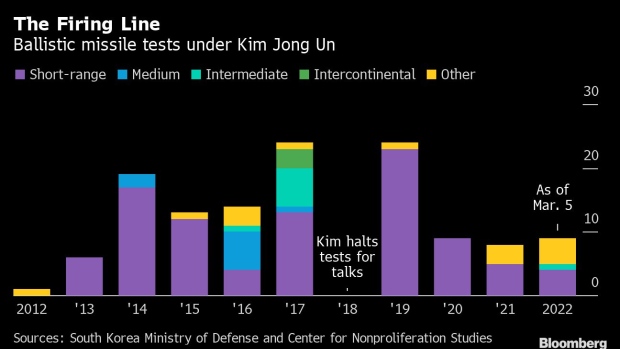Mar 13, 2022
North Korea May Test ICBM as Soon as This Week, Yonhap Reports
, Bloomberg News

(Bloomberg) -- North Korea could launch an ICBM as soon as this week, the Yonhap News Agency reported, in what would be its most serious provocation in five years as South Korea undergoes a presidential transition and the world focuses on Russia’s invasion of Ukraine.
South Korea and the U.S. have detected signs of an imminent test of an intercontinental ballistic missile, Yonhap reported Sunday, citing unidentified South Korean government officials. The U.S. said last week that North Korean launches on Feb. 26 and March 4 were intended to test elements of an ICBM that weapons experts believe could be armed with multiple warheads in a bid to overwhelm defenses.
North Korea was most likely to test its ICBM from a transporter-erector launcher, and fire the missile in a lofted trajectory, Yonhap said. This would give spy satellites less time to detect a test, as opposed to the more time-consuming process of firing off an ICBM from a launchpad.
North Korea hasn’t test-launched an ICBM since November 2017, which at the time was a major breakthrough in Kim’s effort to show he can threaten the entire U.S. mainland. U.S. officials have said the recent tests of suspected ICBM components point to a launch of the Hwasong-17, which is believed to be the world’s largest road-mobile missile of its kind. North Korea is banned by United Nations resolutions from conducting any ballistic missile tests.
Kim Jong Un’s regime willingness to ramp up tensions will test South Korea’s incoming president, Yoon Suk Yeol, while possibly giving Pyongyang greater leverage in any negotiations over sanctions choking his state’s paltry economy. Yoon -- a conservative, who takes office in May -- has pledged to advance a hawkish line on foreign policy that would bolster the alliance with the U.S.
“Kim can both set the tone for inter-Korean dynamics and gauge the incoming Yoon administration’s threshold for North Korean provocations,” said Soo Kim, a policy analyst with the Rand Corp. who previously worked at the Central Intelligence Agency. “And depending on Yoon’s response, Kim will either temper or dial up his aggression.”
There were indications before South Korea’s tightly contested election that Kim Jong Un had put his country on a path to resume nuclear and ICBM testing. The change in leadership from the accommodative stance of outgoing President Moon Jae-in to Yoon, could make it easier for Kim’s propaganda apparatus to sell the escalation to the domestic audience.
In addition, South Korea has detected signs that North Korea is working to restore demolished underground tunnels at its Punggye-ri nuclear test site, where it conducted all six of its nuclear weapons tests, Yonhap reported Friday, citing unidentified officials. North Korea carried out what it said was the demolition of the test site in May 2018, bringing in foreign journalists to witness the event.
Its last nuclear test was in September 2017, when it set off what was its most powerful device by far with an estimated yield of between 120-250 kilotons. Suspending ICBM launches and the demolition at the nuclear test site helped lay the ground for an unprecedented summit a few weeks later between then U.S. President Donald Trump and the North Korean leader.
Kim may believe he can escape more penalties since traditional backers China and Russia, which have veto power at the UN Security Council, have already called for winding back some of the sanctions already imposed on Pyongyang. They might not have much appetite to tighten sanctions now as global pressure is being applied to the Kremlin for its war in Ukraine.
Over the past few months, Kim Jong Un has tested new weapons including a hypersonic glide vehicle, designed to use high speeds and maneuverability to evade U.S.-operated interceptor systems and hit allies South Korea and Japan, which host the bulk of America’s troops in the region. North Korea also test-fired in January first time in about five year an intermediate-range missile with a range that could hit U.S. forces in Guam.
©2022 Bloomberg L.P.





